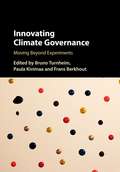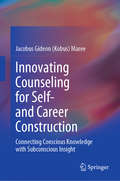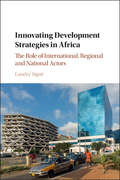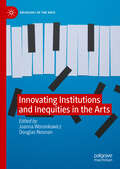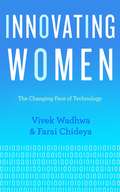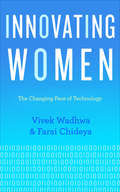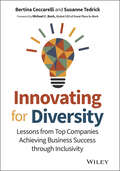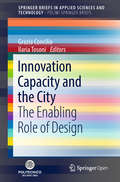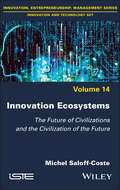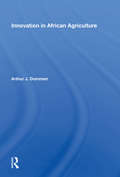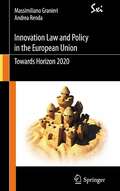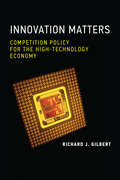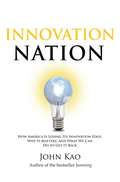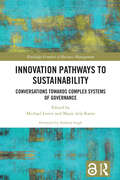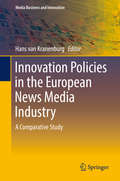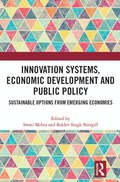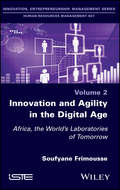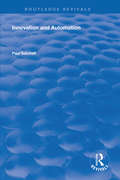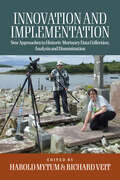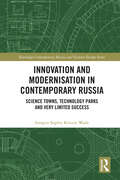- Table View
- List View
Innocent Weapons: The Soviet and American Politics of Childhood in the Cold War (The New Cold War History)
by Margaret E. PeacockIn the 1950s and 1960s, images of children appeared everywhere, from movies to milk cartons, their smiling faces used to sell everything, including war. In this provocative book, Margaret Peacock offers an original account of how Soviet and American leaders used emotionally charged images of children in an attempt to create popular support for their policies at home and abroad. Groups on either side of the Iron Curtain pushed visions of endangered, abandoned, and segregated children to indict the enemy's state and its policies. Though the Cold War is often characterized as an ideological divide between the capitalist West and the communist East, Peacock demonstrates a deep symmetry in how Soviet and American propagandists mobilized similar images to similar ends, despite their differences. Based on extensive research spanning fourteen archives and three countries, Peacock tells a new story of the Cold War, seeing the conflict not simply as a divide between East and West, but as a struggle between the producers of culture and their target audiences.
Innovating Climate Governance: Moving Beyond Experiments
by Bruno Turnheim Paula Kivimaa Frans BerkhoutAfter the perceived failure of global approaches to tackling climate change, enthusiasm for local climate initiatives has blossomed worldwide, suggesting a more experimental approach to climate governance. Innovating Climate Governance: Moving Beyond Experiments looks critically at climate governance experimentation, focusing on how experimental outcomes become embedded in practices, rules and norms. Policy which encourages local action on climate change rather than global burden sharing suggests a radically different approach to tackling climate issues. This volume reflects on what climate governance experiments achieve, as well as what happens after and beyond these experiments. A bottom-up, polycentric approach is analysed, exploring the outcomes of climate experiments and how they can have broader, transformative effects in society. Contributions offer a wide range of approaches and cover more than fifty empirical cases internationally, making this an ideal resource for academics and practitioners involved in studying, developing and evaluating climate governance.
Innovating Counseling for Self- and Career Construction: Connecting Conscious Knowledge with Subconscious Insight
by Jacobus Gideon MareeThis book sets out to provide context for innovating counseling for self- and career construction. It gives readers insight into the theory underlying an innovative, integrative qualitative-quantitative approach to career counseling.Three key ideas recur throughout the book. First, the idea of not dispensing “advice” to people—instead, enabling them to advise themselves. Second, the idea of listening for instead of to people’s stories to help them choose and construct careers and themselves and shape their career identities. Third, the idea of helping people connect what they know about themselves consciously with what they are aware of subconsciously. The book confronts some of the main challenges posed by Work 4.0 on the workplace but also foreshadows the imminent advent of Work 5.0. It endeavors to promote career counselors’ ability to help people “thrive” at a time when many speculate that work itself is at risk, occupational contexts no longer “hold” workers in the way they used to, and the coronavirus pandemic is disrupting the workplace.
Innovating Development Strategies in Africa: The Role of International, Regional and National Actors
by Landry SignéDuring the second half of the twentieth century, African states shifted away from state-led development strategies, and are now moving towards a strategy of regional economic integration. In this book, Landry Signé explores the key drivers of African policy and economic transformation, proposing a preeminent explanation of policy innovations in Africa through the examination of postcolonial strategies for economic development. Scholars and practitioners in fields as varied as development studies, political science and public policy, economics, sociology and African studies will benefit from Signé's unprecedented comparative analysis, including detailed cases from the often understudied Francophone Africa. First studying why, how and when institutional or policy change occurs in Africa, Signé explores the role of international, regional and national actors in making African economic development strategies from 1960 to date, highlighting the economic transformations of the twenty-first century. Proposes one of the most systematic studies of African economic development strategies since the 1960s, ideal for those seeking to understand the modern climate of economic development in Africa. Offers numerous case studies on the often neglected and unexplored Francophone Africa, which will appeal to those seeking a better understanding of the region. Renews discussion of the relatively unexplored topic of political innovation, and offers a systematic framework to study it.
Innovating Institutions and Inequities in the Arts (Sociology of the Arts)
by Joanna Woronkowicz Douglas NoonanThis book includes evidence-based accounts of inequities in the arts as well as a focus on systems that perpetuate and resolve inequities in this context – a topic of wide interest to researchers and practitioners in arts and culture. The chapters in this volume include both the empirical rigor and a diversity of disciplinary perspectives that makes it an essential piece of scholarship in the arts and culture. The volume is ideal for students and scholars studying areas such as sociology of the arts, cultural economics, and arts management. This collection is the result of a series the Arts, Entrepreneurship, and Innovation Lab at the Center for Cultural Affairs at Indiana University hosted in summer 2022 on the topic of “Innovating Institutions and Inequities in the Arts” co-sponsored by the National Endowment for the Arts and the Doris Duke Foundation.
Innovating Women: The Changing Face Of Technology
by Farai Chideya Vivek WadhwaWomen in technology are on the rise in both power and numbers, and now it's more important than ever to not lose that momentum, to "lean in" and close the gender gap. Although they make up half of the population, only 14% of engineers in the United States are women. They take the seeds of technological advancement and build something life-changing, potentially life-saving. The future of technology depends on the full and active participation of women and men working together, and it is vital that women are both educated and encouraged to go into the tech sectors. <P><P> Hailed by Foreign Policy Magazine as a “Top 100 Global Thinker,” professor, researcher, and entrepreneur Vivek Wadhwa, alongside award-winning journalist Farai Chideya, set out to collect anecdotes and essays from global leaders, sharing how their experiences in innovative industries frame the future of entrepreneurship. With interviews and essays from hundreds of women in STEM fields, including Anousheh Ansari the first female private sector space explorer, former Google[X] VP and current CTO of the USA Megan Smith, Ory Okolloh of the Omidyar Network, venture capitalist Heidi Roizen and CEO of Nanobiosym Dr. Anita Goel, MD, PhD, Innovating Women offers perspectives on the challenges that women face, the strategies that they employ in the workplace, and how an organization can succeed or fail in its attempts to support the career advancement of women.
Innovating Women: The Changing Face of Technology
by Farai Chideya Vivek WadhwaFrom one of Time Magazine's 40 Most Influential Minds in Technology: women across the globe share stories of closing the tech industry&’s gender gap. Women in technology are on the rise in both power and numbers, but we need to accelerate that momentum if we want to "lean in" and close the gender gap. The future of technology depends on women and men working together at their full potential. For that to happen, it is vital that women feel welcomed, rewarded, and respected in tech sectors. Hailed by Foreign Policy Magazine as a &“Top 100 Global Thinker,&” professor, researcher, and entrepreneur Vivek Wadhwa, alongside award-winning journalist Farai Chideya, collect anecdotes and essays from female tech leaders around the world, sharing how their experiences in innovative industries frame the future of entrepreneurship. With interviews and essays from hundreds of women in STEM fields, including Anousheh Ansari, the first female private sector space explorer; former Google[X] VP and current CTO of the USA, Megan Smith; Ory Okolloh of the Omidyar Network; CEO of Nanobiosym Dr. Anita Goel, MD, PhD,; and venture capitalist Heidi Roizen, Innovating Women offers perspectives on the challenges that women face, the strategies that they employ in the workplace, and how organizations can support the career advancement of women.
Innovating for Diversity: Lessons from Top Companies Achieving Business Success through Inclusivity
by Susanne Tedrick Bertina CeccarelliDiscover what business visionaries on the frontiers of diverse and equitable hiring are doing to drive change in their organizations In Innovating for Diversity: Lessons from Top Companies That are Disrupting Old Practices to Achieve Inclusivity, Equity and Business Success, renowned Diversity, Equity, and Inclusion (DEI) and tech specialists Bertina Ceccarelli and Susanne Tedrick reframe the DEI discussion and move it beyond a human resources issue. While it's well established that diverse teams help to advance innovation, the authors explain how principles of innovation can be applied to building highly effective and sustainable diversity, equity and inclusion (DEI) practices embraced by executives across an organization. You'll be inspired by leaders at top companies who identified root causes of limited DEI progress and created smart, bold solutions for increasing representation, developing future talent, and advancing the careers of people often overlooked. In the book, you'll also find: Introductions to the people and companies who have innovated their approaches to diverse hiring, retention, and advancement, and enjoyed pronounced impact on their bottom lines Profiles of committed leaders driving the change towards a more diverse and inclusive workforce Strategies for breaking down the cultural and organizational barriers in companies that remain in place and prevent transformative change A critical resource for senior-level business professionals, managers, and executives, Innovating for Diversity will also prove to be invaluable for people seeking to build their careers from the ground up.
Innovating for the Global South
by Janice Gross Stein Joseph Wong Dilip SomanDespite the vast wealth generated in the last half century, in today's world inequality is worsening and poverty is becoming increasingly chronic. Hundreds of millions of people continue to live on less than $2 per day and lack basic human necessities such as nutritious food, shelter, clean water, primary health care, and education.Innovating for the Global South offers fresh solutions for reducing poverty in the developing world. Highlighting the multidisciplinary expertise of the University of Toronto's Global Innovation Group, leading experts from the fields of engineering, medicine, management, and global public policy examine the causes and consequences of endemic poverty and the challenges of mitigating its effects from the perspective of the world's poorest of the poor.Can we imagine ways to generate solar energy to run essential medical equipment in the countryside? Can we adapt information and communication technologies to provide up-to-the-minute agricultural market prices for remote farming villages? How do we create more inclusive innovation processes to hear the voices of those living in urban slums? Is it possible to reinvent a low-cost toilet that operates beyond the water and electricity grids?Motivated by the imperatives of developing, delivering, and harnessing innovation in the developing world, Innovating for the Global South is essential reading for managers, practitioners, and scholars of development, business, and policy.
Innovating in Urban Economies
by David A. WolfeIn a globalizing, knowledge-based economy, innovation and creative capacity lead to economic prosperity. Starting in 2006, the Innovation Systems Research Network began a six year-long study on how city-regions in Canada were surviving and thriving in a globalized world. That study resulted in the "Innovation, Creativity, and Governance in Canadian City-Regions" series, which examines the impact of innovation, talent, and institutions on sixteen city-regions across Canada. This volume explores how the social dynamics that influence innovation and knowledge flows in Canadian city-regions contribute to transformation and long-term growth.With case studies examining cities of all sizes, from Toronto to Moncton, Innovating in Urban Economies analyzes the impact of size, location, and the regional economy on innovation and knowledge in Canada's cities.
Innovation Beyond Technology: Science for Society and Interdisciplinary Approaches (Creative Economy)
by Sébastien LechevalierThe major purpose of this book is to clarify the importance of non-technological factors in innovation to cope with contemporary complex societal issues while critically reconsidering the relations between science, technology, innovation (STI), and society. For a few decades now, innovation—mainly derived from technological advancement—has been considered a driving force of economic and societal development and prosperity. With that in mind, the following questions are dealt with in this book: What are the non-technological sources of innovation? What can the progress of STI bring to humankind? What roles will society be expected to play in the new model of innovation? The authors argue that the majority of so-called technological innovations are actually socio-technical innovations, requiring huge resources for financing activities, adapting regulations, designing adequate policy frames, and shaping new uses and new users while having the appropriate interaction with society. This book gathers multi- and trans-disciplinary approaches in innovation that go beyond technology and take into account the inter-relations with social and human phenomena. Illustrated by carefully chosen examples and based on broad and well-informed analyses, it is highly recommended to readers who seek an in-depth and up-to-date integrated overview of innovation in its non-technological dimensions.
Innovation Capacity and the City: The Enabling Role of Design (SpringerBriefs in Applied Sciences and Technology)
by Grazia Concilio Ilaria TosoniThis open access book represents one of the key milestones of DESIGNSCAPES, an H2020 CSA (Coordination and Support Action) research project funded by the European Commission under the Call “User-driven innovation: value creation through design-enabled innovation”. The book demonstrates that adopting design allows us to embed innovation within the city so as to arrive at feasible answers to complex global challenges. In this way, innovation can become disruptive, while also sparking a dynamic of gradual change in the “urbanscape” it acts within. To explore this potential, the book puts forward the concept of “design enabled innovation in urban environments” and examines the part that the city can play in promoting and facilitating the adoption of design among public and private sector innovators. This leads to a potential evaluation framework in which a given urbanscape is assessed both in terms of its capacity for generating innovation, and of the nature (more or less design-dependent or design-prone) of the innovative initiatives it hosts. This thread of reasoning holds many promising implications, including a possible “third way” between those who dream of an alternative economic model where revenues and growth are sacrificed on the altar of social and environmental respect, and the supporters of the traditional market-based view, who feel it is enough to add a touch of responsibility and concern to a system that should continue rewarding the profitability of innovations.
Innovation Ecosystems: The Future of Civilizations and the Civilization of the Future
by Michel Saloff-CosteOur current situation, marked simultaneously by the Anthropocene, global warming, digitization and exponential artificial intelligence, leads us to sudden and total change in global civilization and, de facto, to rebuilding the foundations of the international economy. Innovation Ecosystems explores the risks and opportunities facing the contemporary world by analyzing, comparing and categorizing the world&’s most dynamic innovation ecosystems by region and city. This includes the identification of key characteristics – common or original – and learning from them in terms of culture, management, system and structure, in order to meet current challenges and think about civilizations of the future.
Innovation In African Agriculture
by Arthur J. DommenThis book looks at the input-output relations of low-resource agriculture in Africa and shows how the intensification process through the application of modern technologies can work successfully to raise productivity and to sustain production over the long term.
Innovation Law and Policy in the European Union: Towards Horizon 2020
by Massimiliano Granieri Andrea RendaThe book provides a critical overview of innovation policy in Europe and a synopsis of the current institutional framework of Europe shaped after the Europe2020 strategy and in view of the upcoming Horizon2020 agenda. What emerges is a rather gloomy outlook for the future of Europe's innovation, unless EU institutions and Member States will decide to streamline existing policies and build a "layered" model of innovation, in which governments act as investors in key enabling infrastructure such as ICT and education; as enablers of large technology markets where researchers and entrepreneurs can meet; and as purchasers of innovation when key societal challenges are at stake. The book contains proposals for the future innovation strategy of the EU and a specific analysis of areas such as the unitary patent, the transfer of technology (particularly as far as climate-related technologies and IP markets are concerned), standardization, and the digital agenda.
Innovation Matters: Competition Policy for the High-Technology Economy
by Richard J. GilbertA proposal for moving from price-centric to innovation-centric competition policy, reviewing theory and available evidence on economic incentives for innovation.Competition policy and antitrust enforcement have traditionally focused on prices rather than innovation. Economic theory shows the ways that price competition benefits consumers, and courts, antitrust agencies, and economists have developed tools for the quantitative evaluation of price impacts. Antitrust law does not preclude interventions to encourage innovation, but over time the interpretation of the laws has raised obstacles to enforcement policies for innovation. In this book, economist Richard Gilbert proposes a shift from price-centric to innovation-centric competition policy. Antitrust enforcement should be concerned with protecting incentives for innovation and preserving opportunities for dynamic, rather than static, competition. In a high-technology economy, Gilbert argues, innovation matters.
Innovation Nation
by John KaoNot long ago, Americans could rightfully feel confident in our preeminence in the world economy. The United States set the pace as the world's leading innovator: from the personal computer to the internet, from Wall Street to Hollywood, from the decoding of the genome to the emergence of Web 2.0, we led the way and the future was ours. So how is it, bestselling author and leading expert on innovation John Kao asks, that today Finland is the world's most competitive economy? That U.S. students rank twenty-fourth in the world in math literacy and twenty-sixth in problem-solving ability? That in 2005 and 2006 combined, in a reverse brain drain, 30,000 highly trained professionals left the United States to return to their native India? Even as the United States has lost standing in the world community because of the war in Iraq, Kao warns, the country is losing its edge in economic leadership as well. The future of our prosperity, and of our national security, is at serious risk. But it doesn't have to be this way. Based on his in-depth experience advising many of the world's leading companies and studying cutting-edge innovation "best practices" in the most dynamic hot spots of innovation both in the United States and around the world, Kao argues that the United States still has the capability not only to regain our competitive edge, but to take a bold step out ahead of the global community and secure a leadership role in the twenty-first century. We must, though, take serious and concerted action fast. First offering a stunning, troubling portrait of just how serious is the erosion in recent years of U.S. competitiveness in innovation, Kao then takes readers on a fascinating tour of the leading innovation centers, such as those in Singapore, Denmark, and Finland, which are trumping us in their more focused and creative approaches to fueling innovation. He then lays out a groundbreaking plan for a national innovation strategy that would empower the United States to actually innovate the process of innovation: to marshal our vast resources of talent and infrastructure in the particular ways that his studies of innovation have shown lead to transformative results. Innovation Nation is vital reading for all those Americans who are troubled by the great challenges the United States faces in the ever-more-competitive economy of our twenty-first-century world.
Innovation Pathways to Sustainability: Conversations Towards Complex Systems of Governance (Routledge Frontiers of Business Management)
by Michael Lester Marie Dela RamaThe book offers insights into reconciling innovation with sustainability and identifying key stakeholders responsible for the reconciliation. Through conversations with experts in various fields, the intersection of innovation, sustainability, governance and complex systems in a rapidly changing climate-driven world is discussed.Countries around the world face the urgent existential challenge to tackle climate change and CO2 emissions. In its discussions of case studies of key economic sectors in Australia, this book focuses on the emerging experience with harnessing innovation to sustainability. The interdisciplinary approach to the complexity of climate change and policy making provides readers an opportunity for thoughtful discussions and lessons to be learnt from multiple angles.This is a vital resource for scholars in climate studies, innovation and sustainability that also confronts important challenges facing policymakers, government and society.
Innovation Policies in the European News Media Industry
by Hans Van KranenburgThis book explores the importance and the types of media innovation policies formulated and implemented in various European countries. Each country analysis illustrates the evolution and structure of news media markets and media cross-ownership policies in recent years and evaluates how innovation policies stimulate innovative activities in journalism and news media. The main objective of this book is to promote discussion on how innovation policies can help the news media industry to meet development needs and requirements in the future. It will help scholars, politicians and practitioners in the media industry to identify best practices to support innovation in a rapidly changing news media landscape.
Innovation Systems, Economic Development and Public Policy: Sustainable Options from Emerging Economies
by Swati Mehta Baldev Singh ShergillThis book looks at the policy challenges confronting India and other developing countries in creating a robust, sustainable and industrialized economy. It investigates different facets of the nature, structure, growth and impact of innovation in industries, education and within institutions to foster greater productivity and growth. The volume examines systems adopted to boost innovation and diffusion of technology in different economies while also mapping their success and failures. It offers suggestions for the future for long-term growth, sustainability and inclusiveness amidst dynamic, fast-changing technological frontiers using examples and case studies from India, Sri Lanka and Malaysia, among others. The chapters in the book, written to honour the academic work of Professor Lakhwinder Singh in the field of development economics and innovation economics, highlight the importance of adopting and adapting new technologies and development models to local contexts and small industries. An important contribution to research on innovation economics, this interdisciplinary book will be of interest to students, researchers, practitioners and policy-makers working in industrial economics, international economics, political economy, innovation economics, institutional economics, industrial organization and international trade.
Innovation and Agility in the Digital Age: Africa, the World's Laboratories of Tomorrow
by Soufyane FrimousseAfrica is a laboratory for managerial and societal innovations built out of pragmatic arrangements. Some African companies offer products and services that go beyond the standard practices of their international counterparts, based on original and inventive managerial characteristics. Such success stories outline a new model of management and innovation for companies in the digital era.The African innovations that have emerged over the past ten years are directly linked to a managerial model that perfectly meets the demands of the digital era. These new organizations indicate that good managerial practices and innovation models also come from the Global South and no longer exclusively from the East Coast of the United States. Understanding these dynamics is of great theoretical and practical interest for the many companies struggling to seize the opportunities for growth in Africa.
Innovation and Automation (Routledge Revivals)
by Paul SatchellFirst published in 1998, this book links the forces of innovation and automation positively by shifting the focus on human-machine interactions from the current, technology-centred approach, to one where sharing is evolved and creativity is no longer suppressed. It provides a unique way of understanding innovation in organisations, by using an environmental interaction approach to understand creativity and its translation into innovatory behaviour. The current dampening of creativity in organisations is made meaningful by explaining organisational behaviour in terms of rituals. The author succinctly assembles the current evidence that the prevailing technology-centred approach to automation is in part responsible for the inability of humans to be creative in work situations. Many of the behavioural constraints necessary for this type of automation paralyse the translation of creativity into innovatory behaviour. In producing an antidote to the technology-centred approach, he moves beyond current human-centred thinking, to an approach where humans and machines share by using the same processes that underlie the sharing between humans. This sharing-centred approach to automation is explained and illustrated. Throughout the book the current state of human-machine interactions is illustrated with vignettes from aviation, medicine and from organisations. The book also discusses three pictures of future human-machine interactions of the flightdeck, in primary care medical practice, and in boardrooms of major organisations. The main readership includes all who are interested in innovation and organisational development, especially in the technology based industries and services such as healthcare, transportation, manufacturing and information systems; it provides essential new ideas for senior executives, strategic consultants, specialists in organisational behaviour and human resources, members of regulatory agencies and other government facilities, and academicians and researchers.
Innovation and Business Partnering in Japan, Europe and the United States (Routledge Studies in the Growth Economies of Asia #Vol. 67)
by Ruth TaplinInnovation studies and partnering/collaborative alliances are rapidly growing areas of interest. Originally combining the two areas, this book examines the role of business partnering as a pathway to innovation for small and medium enterprises – SMEs. This text outlines global and regional trends, focusing in particular on the role of Poland and Eastern Europe as an emerging region for new innovative ideas, how innovation is promoted in the United States, and how it is facilitated in Japan. It assesses the reasons why American SMEs are significantly ahead of their European counterparts in the fields of research and development investment and innovation, and demonstrates how business partnering can assist in increasing research and development investment, profit, finding new suppliers and aiding growth. In addition, the book shows how business partners can cut the costs of doing research for innovation and analyzes the threat that poorly constructed and over-burdensome regulation and bureaucracy pose to innovation. This book is a timely contribution to the literature on both innovation and business partnering in Japan, Europe and the United States.
Innovation and Implementation: Critical Reflections on New Approaches to Historic Mortuary Data Collection, Analysis, and Dissemination
by Harold Mytum and Richard VeitProviding a comprehensive set of guidance to assist researchers wishing to carry out, curate and disseminate field research at a historic burial ground, chapters offer up to date methods for surface and subsurface survey and for the recording and archiving of burial monument data. Divided into three parts considering documentary research and recording of mortuary landscapes, reflections on memorial recording projects, and archiving and wider dissemination of data and interpretations. Also included is the archaeological potential of pet cemeteries and other pet memorials. Discussions therefore include how methodologies may or may not be applicable to both human and animal subjects.
Innovation and Modernisation in Contemporary Russia: Science Towns, Technology Parks and Very Limited Success (Routledge Contemporary Russia and Eastern Europe Series)
by Imogen Sophie WadeThis book examines how technological modernisation and innovation policies have been implemented in Russia from the Soviet era to the present day. It discusses how since about 2000 the Russian state has attempted to address the country’s excessive dependence on natural resources by implementing an ambitious programme of economic modernisation, including giving innovation more policy prominence, boosting state funding for research and development and innovation, and emphasising science towns and technology parks as key instruments for stimulating innovation. Based on extensive original research, taking a multidisciplinary approach, and including detailed case studies, the book explains why, despite these efforts, Russia is performing comparatively poorly in innovation outcomes. It argues that a key factor is the country’s political economy model in which science, technology, and innovation policies are mainly controlled and funded by the federal centre of power and led by domestic political and economic elites.

